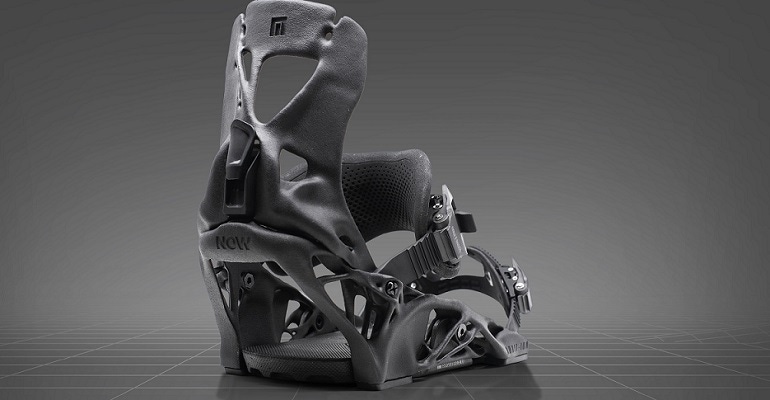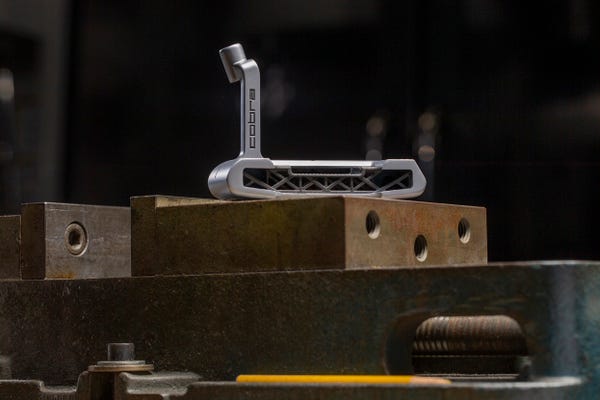Using additive manufacturing technology, HP brings mass customization to sports.
March 15, 2021

3D printing has upended the traditional design process, encouraging companies to take innovative approaches through all phases of design – from development and testing to final production. 3D printing’s additive manufacturing process also supports mass-customization – a manufacturing approach companies have pursued for decades – with mixed results.
HP took its expertise in inkjet processes into 3D printing with notable results. The company recently turned its expertise in 3D printing to the sports equipment industry. HP focused on mass customization to personalize products from golf clubs to snowboard bindings. “HP is working with sporting goods companies as a partner to make an immediate, but also transformational, impact on their business,” David Woodlock, application development and design manager at HP, told Design News. “With the materials and performance our parts are bringing, we’re enabling rapid development of new products with end-user testable prototypes.”

HP’s move into sports products is ambitious. The company seeks to become a major design and manufacturer of sports equipment, aiming to participate in all stages of design and production. “HP is charting a path for 3D printing to engrain itself in the sports industry by enabling new manufacturing capabilities and designs,” said Woodlock. “Our 3D printing solutions provide a broad range of support – from initial design and testing to full-scale production. A key differentiator of our 3D printing technology is our ability to support performance and development at the high price points, while also providing a roadmap to scale down to more mass-market opportunities.”
HP’s goal is to support innovative approaches to equipment design. “We recently partnered with Cobra Golf, a leader in golf club innovation, to create the KING Supersport-35 putter that features a fully 3D printed metal body with an intricate lattice structure,” said Woodlock. “We offered creative reinvention in developing sports equipment.”

Improving the User’s Sports Experience
Unlike many consumer products, sports equipment is very personalized It is designed to fit the human body and human movement. Thus, the more personalized the better. “The industrial designers and product designers in the sporting goods industry are some of the most human-centered professionals there are. Everything revolves around how to improve the experience of the participant, particularly as that experience is driven by personal preference,” said Wiidlock. “Collaboration to support personalized equipment allows our technology to impact design and creativity at various stages.”
The key to personalized equipment design is the mass customization capabilities of additive manufacturing. “We are working with companies who use 3D printing’s design flexibility to create a more comfortable experience for customers,” said Woodlock. “That involves improving touchpoints and padding.”
Safety is also a critical factor in sports equipment. 3D printing can take a role in safety as well. “We are collaborating with groups using the technology to improve safety for the participant, by creating equipment that controls impact in a new way,” said Woodlock. “We’re working with companies like Cobra Golf to create better-performing products that can be deployed at the highest levels of the sport.”
3D Printing Supports Mass Customization
While most companies would like to customize their products for individual customers, in sports equipment, that goal is particularly important, since equipment affects performance. “According to HP’s Digital Manufacturing Trends Report, over 91% of respondents want to explore mass customization for their business via 3D printing capabilities,” said Woodlock. “In the sports industry, where passions revolve around choosing how to engage in sports and activities, a piece of equipment – personalized or not – can shape or enhance the experience profoundly. Simply put, sporting goods make things personal.”
During the pandemic, many people have turned to individualized sports. “One of the big trends we’ve seen emerge from Covid-19 is a surge of new participants in activities like cycling, Nordic skiing, and paddling,” said Woodlock. “With all these new participants come people of different sizes, shapes, ages, and abilities. Where 3D printing steps in is the technology’s ability to support manufacturers as they respond to the needs of new consumers in a way that simply wasn’t possible before.”
One of the promises of additive manufacturing is its ability to produce designed-for-one products. “3D printing can create more options and choices for consumers, enabling product creation that satisfies a larger and more diverse set of customers,” said Woodlock. “And where needed and valuable, 3D printing can enable the creation of fully customized solutions and products that ultimately enhance experiences across the sports industry.”
Rob Spiegel has covered manufacturing for 19 years, 17 of them for Design News. Other topics he has covered include automation, supply chain technology, alternative energy, and cybersecurity. For 10 years, he was the owner and publisher of the food magazine Chile Pepper.
About the Author(s)
You May Also Like





